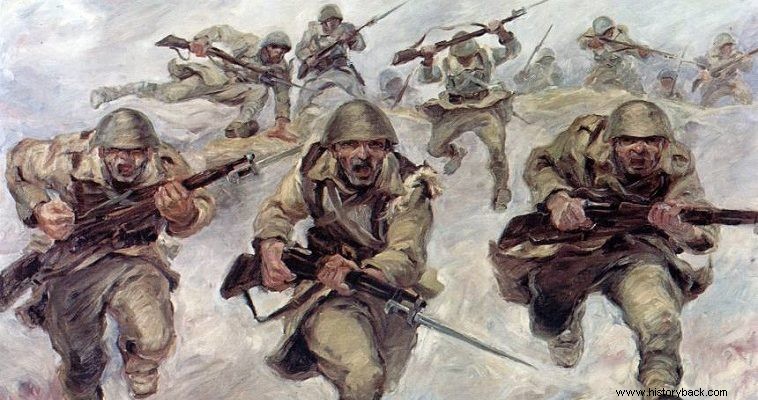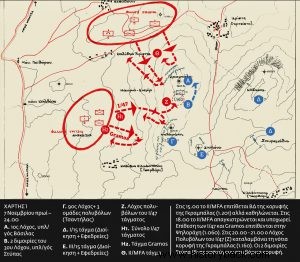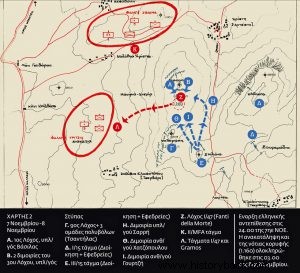
After the failure of the Italian infantry to hold Grabala, the baton of attacks is taken by the artillery, which from the morning of November 4th, with a storm of fire, hammers the heights of Grabala-Psilorachi, as well as that of Assonissa further west , as well as the hills around Kalpaki. The Italian air force is coming in swarms, dropping tons of bombs and strafing the defenders' trenches from a low altitude.
OF THE MONTH OF LAGARIS
SOURCE:EDITORS' NEWSPAPER
The results of these actions are not so substantial but mainly psychological. The endurance of the defenders is tested as the trenches in the barren Grabala were rough and bare, compared at least to those from Kalpaki to Vrontismene, where the trenches were in wooded surroundings and protected by a canopy of tree trunks.(1)
K. Pantazis is very informative in his descriptions, explaining that strong defensive works had been built on both sides of the narrow Kalpaki, with trenches running vertically in three lines, protected by durable canopies, with underground entrances and wire fences.
While in Grabala-Psilorachi the trenches were kneeling and uncovered because their construction work was delayed, since Grabala was included in the resistance location only two months before the declaration of war.(2)
The chariots of the "Centaurs"
On the 5th of November the attention of both opposing staffs was turned to the Centaur attack in front of Brontismene. The swamps of Parakalamos prove to be an insurmountable obstacle for the powerless L33/35, who become easy targets for the artillery of Gribiani. (3) Not that things are "quiet" in Grabala. The bombardment continues with unabated intensity throughout the morning of November 5, while in the afternoon the infantry attacks are repeated in waves. But with the usual results.
The attackers are intercepted by the combined fire of machine guns and mortars and are forced to retreat with significant casualties. The exact same "scenario" is repeated during November 6. And while it appeared, from the morning of November 7, that we would have "one of the same" (ie:bombardment-infantry attack-repulse) General Rossi(4) decided to change tactics and ordered a night attack. [map 1]
The operation started at 15.00. (5) The II/MFA battalion sets out from Kalivia Aristis and ascends the northwestern slopes of Grabala with the aim of capturing the northern peak (1201). Leading the way is the 5th Company, commanded by Centurione (6) Fachini, with the 4th Company following behind.
But before they approach the main line of the Greek defense, they are pinned down in front of a rocky rampart defended by a platoon of the 1st Company under Captain D. Ioannou. The Greek artillery also joins the dance, cutting off the 4th Company from the advancing 5th with a barrage of fire. Around 18.00, parallel to the II/MFA and a little further south, the I/47 battalion sets out in turn to capture Psilorachi (1,060), with the Gramos battalion marching on its right.
The sounds of battle are heard to the north and a patrol of I/47 is ordered to turn that way to make contact with II/MFA. But it falls on Stypa's two platoons guarding the southern peak (1160). The patrol is easily intercepted and returns back, without of course gaining the required contact.
Withdrawal
Darkness has covered the battlefield. The attackers move slowly and cautiously in order to carry out the final night strike, a move carried out by the battalions attacking Psilorachi.(7)
To the north of Grabala, however, the cut off Fachini, having lost all support from the 4th Company and being severely tested by the Greek fire, communicates with console (8) Volante himself and asks to be allowed to disengage and retreat back to Kalivia Aristis. Thus at the northern peak (1201) the aggressive energy is effectively dissipated before it even manifests itself.
In Psilorachi, the attack takes place but with the known results. The machine guns of the man Tsandila repel the attacks and quickly the attackers are forced to abandon their attempt. They are thus slowly starting to retreat.
In Italian hands
Where it seems that all is over, that is between 20.00 and 21.00, the 4th Machine Gun Company of Lt. Basurto Luigi, in the deep darkness of November, takes the wrong way back and falls upon Stypa's two platoons on the southern summit ( 1160)!
The defenders are surprised, overturned and take refuge on the northern peak (1201) where they join those of Vasilas. The southern peak of Grabala is once again in Italian hands. [map 2]
On the northern summit, Stypa's overturned platoons are reorganized, reinforced with Vasila's reserve platoon, and deployed facing south. But what is most important is the immediate reaction of III/15 Battalion. In Styliana, every available man is mobilized. 3 platoons are thus formed, which as soon as possible rush towards the southern peak (1160).
The squadrons of Hatzopoulos, Sarris and Gourzis. That of Sarris is sent from the eastern slopes to reinforce and contact the Stypa-Vassilas detachments, while the Hatzopoulos-Gourzi detachments march towards Psilorachi and from there form a front, from the south, against the Italian company. In this way the Italians are surrounded from 3 directions!
A little before 24.00 everything is ready for the event of the counterattack. The start signal is given with the bugle and all platoons charge against the Italian positions. A fierce fight ensues, in the thick darkness, where the explosions of grenades and bursts of machine guns alternate with the wail of the bayonet.
The Italians, unreinforced, attacked from all the above directions, fatally overturned and fled towards the only way out. That is, towards the western slopes and back to the base of their battalion in Diakopia. At 03.00 on the morning of November 8, the entire ridge of Grabala is again in the hands of the 15th Regiment.
At dawn on November 8, the losses are counted. On the Greek side, Captain Hatzopoulos, 1 sergeant and 8 soldiers are dead. Major Gourzis and 29 soldiers were wounded. (9) On the Italian side, the diary of the 47th Regiment records for the 4th Company:1 officer and 7 soldiers dead. 5 officers and 79 soldiers wounded.
11 hoplites (apparently the prisoners) are also listed as missing. A great impression is made by the metal plates that the Italians had on the collars of their shirts, which bore the image of a skull and the inscription "47 RGT Fanti della Morte".(10)
The results
But what characterizes November 8, 1940 is the feeling that the Italian attack has already exhausted all possibilities of breaking the defensive location of Kalpaki. General Charalambos Katsimitros(11) writes characteristically:
"However, from observations of the day, it was discovered that the enemy forces in front of the front adopted a rather defensive arrangement, because their artillery also changed positions rather towards the rear and the tanks withdrew undecided in front of the front".
In other words, we essentially have the admission, from the Italian side, that in practice the decisive strike in Kalpaki has failed.
In relation now to the second critical night of November 7-8 in Grabala, the inability of the Italian units to coordinate their action is evident. A fact that is decisive in terms of the outcome of the final result. An issue that of course rests with the highest and highest leadership of the Italian military hierarchy and not the ordinary Italian soldier, who fought with self-sacrifice on several occasions.
Regarding the Greek defense, we can only point out the poor assessment of adequate guarding of the southern peak of Grabala, which was occupied by the Italians twice. An event that would have had unforeseen consequences, which fortunately for the 15th Regiment were avoided due to timely counter-attacks on the morning of the 3rd and midnight of the 7th-8th of November.
At this point we should also emphasize the great advantage that the Greek soldier had over his opponents. The Gianniotes(12) of the 15th Regiment had an excellent knowledge of the battlefield, they knew it every inch of it, which allowed them to know every path and every bad place in the area, as a result of which they moved faster and more decisively even in the dense darkness of November. And this, in addition to the indisputable moral motivation, that is, the Greek soldiers were literally defending their homes and their families.
In closing and for the sake of historical accuracy, I would like to emphasize the fact that while the northern peak of Grabala (1201) was "stepped" by the Italians at least once (night of November 3rd) and the southern peak (1160) two more, the one that really turned out to be a "separate castle" was the peak of Psilorachi (1060), which, despite the furious attacks and relentless bombardments it suffered, never wavered for a moment.
Psilorachi held out, Grabala was held "tooth and nail", Kalpaki repelled the main spearhead of the Italian invasion and marked the Greek counter-attack, which led to what went down in history as the "Epic of Albania".


Explanations of part two
1. K. Pantazis, p. 65.
2. K. Pantazis, p. 49.
3. This is the Artillery Squadron of the legendary Major D. Kostakis.
4. General Carlo Rossi, commander of XXV "Tsamouria" Army Corps.
5. Calendar II/MFA Battalion.
6. Centurione:rank of the blackcoats equivalent to that of the captain.
7. These are the two Battalions I/47 and Gramos of the Trizio Phalanx.
8.Console:rank of the blackcoats corresponding to that of the colonel. In this particular case Volante was the commander of the 1a Legione d'Assalto CC.NN of the Milizia Fascista Albanese (MFA), to which II/MFA organically belonged.
9. K. Pantazis, p. 68.
10. Because in the Greek literature a lot has been written imaginatively on the specific subject, e.g. death squad etc. (even the present K. Pantazis mistakenly speaks of an "elite order"), I must restore things to their proper dimension. Many times the reality is much simpler than we want to present it. In the Italian army, during World War II, each regiment carried a distinctive motto or "nickname". The 47th constitution therefore brought, from A' P.P. even, the "nickname" "Fanti della Morte", without this meaning that it was something special in relation to the rest of the Italian infantry regiments.
11.X. Katsimitros, p 135.
12. During the period under review, the Greek regiments each had a specific recruiting area. The 15th Regiment had the Prefecture of Ioannina. In other words, it consisted of hoplites who came from the above prefecture.
Bibliography
1) GES/DIS:The Italian Invasion (October 28 - November 15, 1940).
2) Charalambos Katsimitros:"Epirus Promachousa".
3) Konstantinos Pantazis:"The two NO".
4) Giorgos Margaritis:"The war in Albania and the first period of the Occupation".
5) Visconti Prasca:"I invaded Greece".
6) Mario Montanari:"La campagna di Grecia".
7) Piero Crociani:"Gli Albanesi nelle Forze Armate Italiane 1939-1943".
8) Ufficio Storico, Stato Maggiore Dell Esercito:Diario Storico MFA.
9) Ufficio Storico, Stato Maggiore Dell Esercito:Diario Storico 47 RGT.
